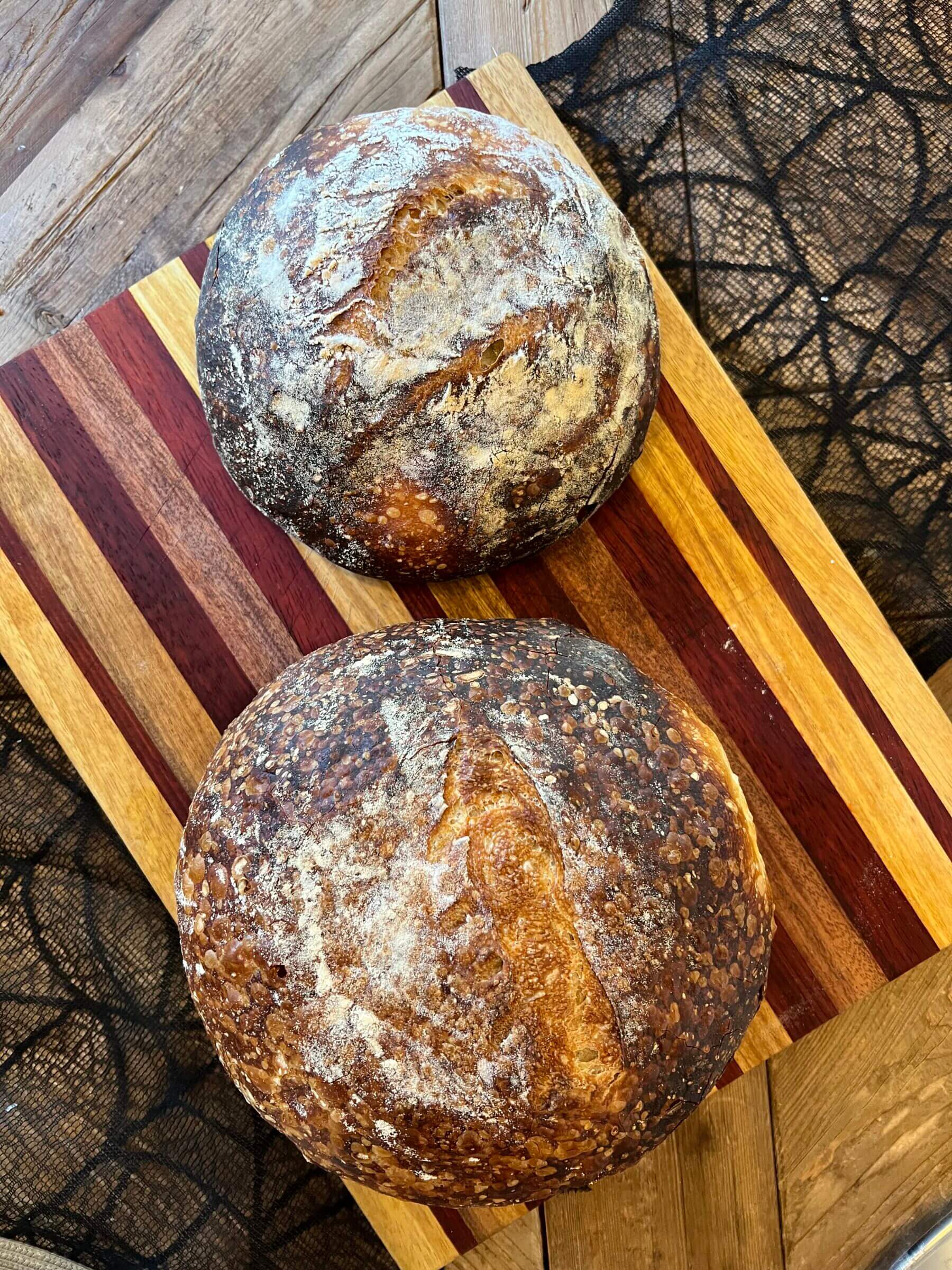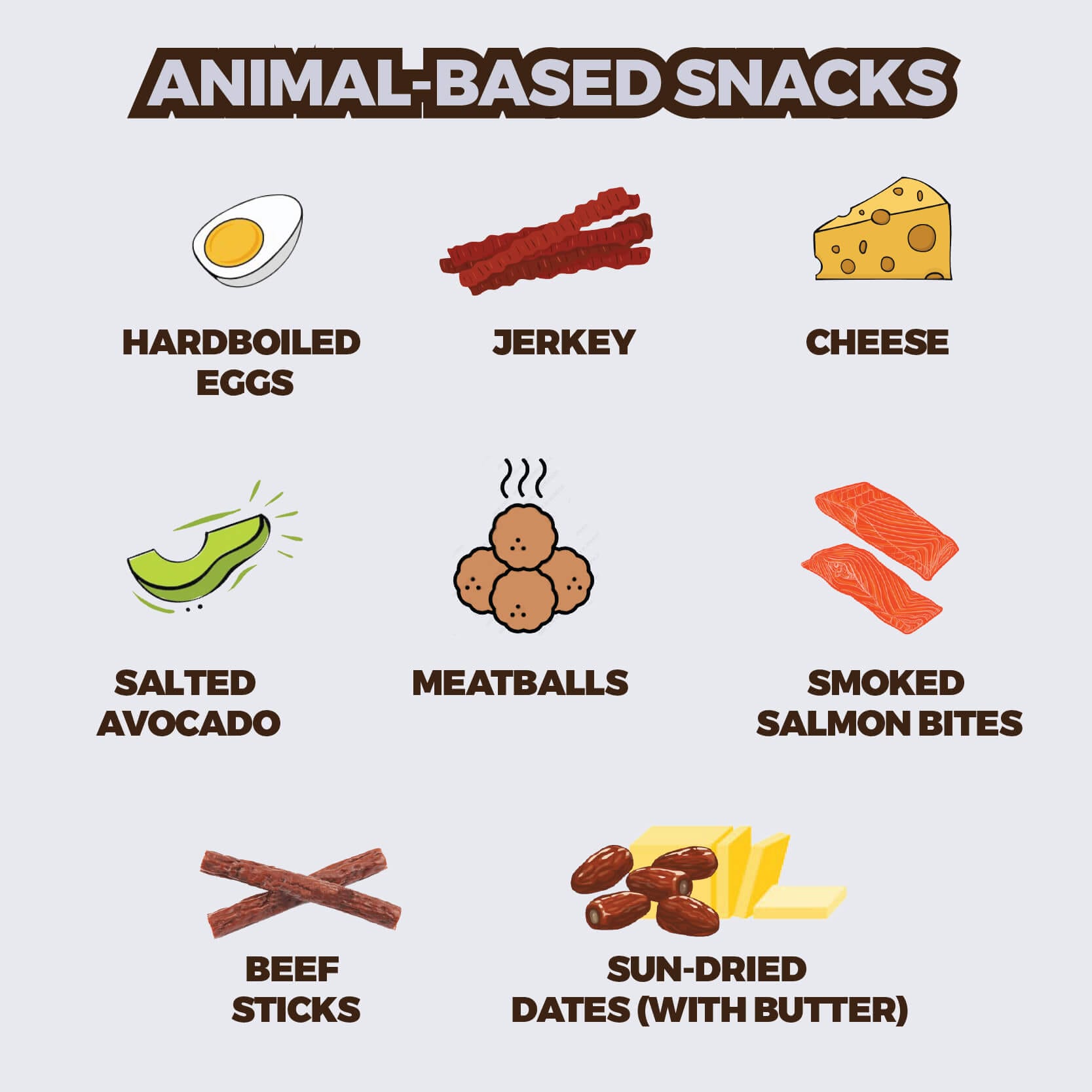My family and I have been following an animal-based diet since 2021. In this article, I’ll share the following:
- What an animal based diet is.
- The pros and cons of animal-based eating.
- Why an animal-based diet is superior to the paleo diet (despite their similarities).
- Why an animal-based framework is easier to maintain than a strict carnivore or ketogenic diet.
- Why counting macros (protein, fat and carbs) is a waste of time (and why you might want to do it anyway).
I’ll also share an animal-based diet food list with additional information to make grocery shopping and meal planning a breeze.
Before we get into the nitty-gritty, let me explain how my wife, two kids and I adopted an animal-based diet to improve our health and well-being.
Our Transition to Animal Based Eating
To make a long story short, my wife and I watched a Netflix documentary several years ago about the ridiculous amount of added sugar the average American consumes yearly. That triggered us to stop buying foods that had added sugar. Shortly after, a mutual friend introduced me to the paleo diet, and despite my wife’s initial protest, we adopted it. Then we discovered low-carb eating, and we began our ketogenic journey before briefly experimenting with a strict carnivore diet for several months.

Along the way, we learned to approach nutrition with a more nuanced perspective, and to better listen to our bodies to understand what foods make us feel our best.
In the summer of 2021, I met Dr. Paul Saladino at an animal-based retreat in Costa Rica. After learning why he now consumes more carbs than he used to (after having been on a strict carnivore diet for several years), I decided also to reintroduce certain carbohydrates into my diet — primarily from raw honey, raw dairy, sweet fruits and a few veggies — to see how my body would respond.
My wife and kids welcomed the change and tagged along. As of this writing, we’re in our third year of animal-based eating and have never felt better.
What Is An Animal-Based Diet?
As the name implies, an animal-based diet is one that’s centered around animal foods, including muscle meat, organ meat, the fat of well-raised animals (preferably ruminants), eggs (preferably pastured), raw dairy (preferably fermented), raw honey (preferably from your region), seasonal sweet fruits (preferably organic) and some of the least-toxic plants, such as cucumbers and squash (scroll down to download my full food and beverage list).
The primary goal of an animal-based diet is to focus on eating foods that are high in bioavailable and readily absorbable micronutrients such as enzymes, vitamins and minerals, and to avoid seed oils and most plant foods that are high in natural defense chemicals (such as antinutrients or phytoestrogens) that can negatively impact your gut and immune health, cause inflammation, and increase your risk for developing a metabolic disease.
Is An Animal Based Diet Healthy?
I firmly believe that an animal based dietary framework best mimics the opportunistic eating patterns humans and our ancestors followed for millions of years, based on scientific evidence and observations of modern hunter-gatherer tribes (such as the Hadza).
However, despite all the available evidence regarding how humans have thrived on an animal based diet over time, there is some pseudo-scientific “evidence” (sponsored by the processed food industry) correlating the consumption of meat and saturated fat with obesity, heart disease, metabolic syndrome and gastrointestinal cancers.
The good news is that all of those claims have been debunked with solid and unbiased scientific evidence, as I explain in-depth in the following articles:
- Why red meat is not unhealthy.
- Why you don’t need vegetables for a healthy diet.
- The key differences between saturated and polyunsaturated fats.
In a nutshell, an animal based diet provides you with all the essential nutrients your body needs to function optionally while removing everything that could potentially be detrimental to your health. There is absolutely nothing you’re missing out on nutritionally by following an animal-based diet.
You even get to consume fiber, although it’s 100% non-essential, as I discussed in my article about fiber and the carnivore diet.
Animal-Based Diet Health Benefits (Pros and Cons)

Pros
- Rich in bioavailable and readily absorbable nutrients.
- Offers a lot of flexibility compared to stricter dietary frameworks (e.g., keto or carnivore).
- Doesn’t prescribe how much protein, fat and carbs you should consume.
- Enables your body and metabolism to function optimally.
Cons
- Much more restrictive than a Standard American Diet (SAD).
- Doesn’t take into consideration certain food preparation methods that can mitigate many plant toxins.
Proponents of animal-based diets argue that by focusing on the most nourishing foods available to humans (animal products) and avoiding the most toxic plant-based foods (including grains, legumes and leafy greens, to name a few), you enable your body and metabolism to function optimally, leading to a decreased risk of disease, increased energy levels, better libido, improved body composition and more.
While I agree with all that, I also think that one of the primary advantages of an animal-based diet is its flexibility and relatively broad food choices.
Specifically, an animal-based diet doesn’t prescribe how much protein, fat and carbs you should consume. For example, you can consume more carbohydrates (from sweet fruits, raw honey or even dairy products) on exercise days than on days you don’t move much (and require less energy).
Of course, if you’ve been following a Standard American Diet (SAD), animal-based eating might look incredibly restrictive to you. But I can tell you that after having done keto for several years and carnivore for a few months, following an animal-based diet is relatively easy and doesn’t feel restrictive at all once you get used to it. It’s also easier to maintain in social settings.

The one gripe I have with animal-based eating is that it doesn’t consider food preparation methods. In other words, it doesn’t account for our ability to process certain foods to make them significantly less toxic and possibly okay to consume (depending on your metabolic health).
Fermenting, soaking, peeling, sprouting, heating and grinding are methods humans have developed over the past 10,000 to 15,000 years to make plant-based foods less toxic.
For example, peeling, slicing, and fermenting potatoes reduces their toxic load and glycemic index, making them OK to consume in moderation (unless you suffer from a metabolic condition or gut issues and are trying to heal).
The good news is that if you’re in good health and learn some basic food preparation methods, you’ll likely be able to add some additional plant foods to your animal-based framework, thus blurring the line between your old and new way of eating.
Don’t get me wrong: there is nothing in plant foods humans need to achieve or maintain optimal health. But mitigating certain plant toxins helps make eating more convenient for the average person who just wants to do better.
Animal-Based Diet Food List
The big question that may be on your mind is what you can and cannot eat on an animal-based diet.
While I encourage you to download my in-depth animal-based diet food list (by entering your email address in the form below), here is an overview of what foods are permitted on an animal-based diet:
- Red meat. I recommend buying the highest-quality meat you can afford. I try to stick to 100% grass-fed beef from regeneratively raised cattle, but if all you can afford is conventionally raised red meat from a discount store (e.g., Costco), that’s better than not eating meat at all. Don’t stress out about it.
- Other meat. There is no doubt that the meat of ruminant animals is nutritionally superior to that of monogastric animals. However, if you have access to well-raised pork or chicken, it’s OK to consume that in moderation. To learn more about why the meat of virtually all monogastric animals you can find in stores is terrible, check out my podcast episode with Dr. Anthony Gustin. That’s one of the reasons why we decided to raise chickens (and soon pigs) on the Kummer Homestead.
- Organ meat. Organs are arguably the most nutrient-dense foods on the planet, and something our ancestors and early humans have eaten for millions of years. The problem is not everyone likes the taste and texture of organs. The good news is you can find high-quality freeze-dried beef organ supplements (such as the ones my wife and I sell at MK Supplements) that offer all the nutrients minus the taste.
- Fat. This includes animal fats (saturated fats), such as butter, ghee and tallow. I’d avoid lard and duck fat unless you know they’re from well-raised animals and are low in polyunsaturated fatty acids (PUFAs). You can learn more about why I recommend avoiding PUFAs in my article about the difference between saturated and polyunsaturated fats.
- Seafood. Certain proponents of animal-based eating, such as Dr. Paul Saladino, argue that seafood has a lower nutritional value than the meat and organs of well-raised ruminants. But I’d say, if you enjoy seafood, go for it. Just avoid larger fish known to have elevated levels of heavy metals, such as mercury, because they can be detrimental to your health.
- Eggs. The eggs of well-raised hens are another superfood we consume daily at the Kummer household. We value eggs so much that we raise our own hens as part of the Kummer Homestead.
- Sweet fruits. Unlike a plant’s stems and leaves, sweet fruits are meant to be eaten (so you can spread the plant’s seeds). That’s why most sweet fruits have comparatively low amounts of defense chemicals when they’re ripe. As a result, they’re generally safe to consume.
- Non-sweet fruits. Certain fruits, including avocados and olives, are also safe to consume due to their relatively low amounts of toxins.
- Least-toxic plants. Certain plants are safe to consume if you peel and deseed them. Examples include cucumbers, zucchini and other types of squash.
- Other foods. You can also enjoy bone broth and bone marrow.
Unfortunately, the list of foods that are off-limits on an animal-based diet would be too long to mention here. But I encourage you to download my animal-based foods list using the form below, which includes all that information and more.
Animal-Based Diet vs. Carnivore Diet

In a nutshell, the carnivore diet is a more restrictive version of the animal-based diet, focusing primarily on red meat. The carnivore diet also has different levels, with the strictest level allowing only red meat, salt and water (also known as the lion diet).
More relaxed levels of the carnivore diet allow eggs and dairy, such as raw milk, kefir and cheeses. Dr. Shawn Baker is one of the most famous proponents of the carnivore diet, and he consumes predominantly red meat (e.g., steaks), eggs and some cheese. Another renowned proponent of the meat diet is Dr. Anthony Chaffee, who, unlike Dr. Baker, also consumes organ meat.
The carnivore diet is an excellent (if not the best) tool to heal various ailments, including gut issues, autoimmune conditions, skin problems and more. I highly recommend a strict carnivore diet if you suffer from irritable bowel syndrome or similar digestive issues. Temporarily switching to carnivore helped me permanently cure my IBS, which I had suffered with for three decades.
However, if you’re metabolically healthy, I don’t think you have to eat only meat. In other words, there is room for other foods, such as the ones that are part of an animal-based diet, that will likely not negatively impact your health.
Animal-Based Diet vs. Paleo Diet

The paleo diet aims to mimic the eating habits of our prehistoric ancestors, taking the perspective that the ideal human diet is the one that fueled millions of years of human evolution. While the animal-based and the paleo diet are similar in many ways, there are also substantial differences you should consider.
For example, the paleo diet doesn’t allow dairy, considering that humans only began domesticating animals about 12,000 years ago. I disagree with excluding raw dairy from your diet, especially when fermented, because of its nutritional value.
I also believe that many of the side effects of dairy consumption stem from pasteurized dairy and not raw dairy.
Without going into great detail on the differences, pasteurizing dairy denatures its proteins. And it kills off many bioactive compounds in raw milk, such as enzymes and vitamins, making it more likely for your immune system to respond to pasteurized milk negatively.
On the flip side, the paleo diet permits many plant-based foods that we now know are toxic for humans, especially without proper preparation. For example, the paleo diet allows leafy greens (some of the most toxic plants known to humans) as well as nuts and seeds, all of which are loaded with defense chemicals that can wreak havoc in your gut.
To be fair, when my wife and I switched from a “no added sugars” diet to a paleo diet almost a decade ago, we noticed a dramatic improvement in our health. However, our idea of a paleo diet then was similar to a modern, animal-based diet. In other words, we consumed a lot of meat, sweet fruits and only a handful of plants, including zucchini and carrots. In a way, we unconsciously avoided some of the more problematic foods, such as leafy greens, until later in our paleo journey.
Coincidentally, while my irritable bowel syndrome quickly disappeared after we switched to paleo, my issues returned later on when we started eating more plant foods, such as leafy greens, brassicas, nuts and seeds.
As a result, an animal-based diet is a more appropriate framework for most humans than the more relaxed paleo diet.
Animal-Based Diet vs. Ketogenic Diet
I followed a relatively strict ketogenic diet for several years before realizing that cutting out all carbs negatively impacted my sleep (i.e., I would frequently wake up and feel ready to go even if it was only 3 a.m.).
I suspect that my heavy training load at the time (I was doing CrossFit five or six times per week) depleted my glycogen stores overnight, causing a spike in cortisol that made me feel wide awake. Once I began reintroducing more carbs into my diet, my sleep improved, and I wouldn’t wake up full of energy in the middle of the night.
That said, the biggest issue I have with a modern keto diet is that it can include foods that I’m convinced are detrimental to your health, including vegetable oils, nut butter and highly processed foods (e.g., keto bars).
In other words, the keto diet doesn’t focus much on the type and quality of the food you’re eating, but almost exclusively on the food’s macronutrient profile.
In other words, you can follow a ketogenic diet by consuming less than 25 grams of carbs per day, regardless of what types of food you eat. While removing carbs (mainly processed carbs) from your diet can be beneficial if you’re trying to lose weight, lower fasting insulin and blood glucose levels, or improve your metabolic flexibility, they’re not the only critical dietary factor. Nutrient density and the types of protein and fat play an equally important role, and the keto diet doesn’t consider that.
I prefer an animal-based diet because it focuses on food quality while leaving the macronutrients (protein, fat, carbs) up to you.
It’s worth mentioning that when I realized the shortcomings of a traditional keto diet, I briefly adopted a Paleolithic ketogenic diet (which also focuses on food quality) before settling on an animal-based diet. If you’re interested in a paleo/keto approach, check out this article and consider downloading my keto/paleo food list.
Why Macros Are Important (And Why They’re Not) on an Animal-Based Diet
One of the things I see many people do is “count their macros.” In other words, they keep tabs on how much protein, fat and carbs they consume daily.
I consider counting macros to be a colossal waste of time for various reasons, including that it’s not sustainable and that not all calories are created equal.
But despite my aversion to counting macros, I firmly believe that they matter. For example, if you’ve been following Dr. Paul Saladino on Instagram, you may have seen him talk about how he consumes 250 to 300 grams of carbs daily.
Those are levels comparable to the Standard American Diet (SAD).
Of course, Saladino gets his carbs from fresh fruits, honey or fruit juices, which are arguably healthier than processed carbs in the form of bread, pasta or doughnuts.
However, it’s essential to understand that while the human body uses protein and fat for more than energy, carbs are only used for energy. Any excess energy is stored as fat. Saladino is an avid surfer whose hobby likely burns several hundred calories daily. That’s why he can get away with consuming so many carbs (even though I question the necessity; I also burn a significant amount of calories daily but consume less than 120 grams).
If you have a somewhat sedentary lifestyle (even if you go to the gym for an hour every day), you’ll likely run into an energy surplus by consuming 250+ grams of carbs daily.
Adding honey or maple syrup to raw milk or drinking a quart of fruit juice may taste delicious if you have a sweet tooth. Still, I doubt that’s advisable for the average person trying to improve their health and body composition.
The bottom line is that an animal-based diet doesn’t restrict your macronutrient intake. Still, I recommend focusing each meal on protein and leveraging carbs and fat as energy sources. In other words, just because fruits are allowed on an animal-based diet doesn’t mean you should consume them at the exclusion of animal protein.
Frequently Asked Questions

Eating healthy doesn’t have to break the bank. For example, consider buying ground beef or cheaper cuts of meat you can prepare in a slow cooker instead of grass-fed ribeyes. You can even find reasonably-priced steaks and ground meat from 100% grass-fed cattle at many discount stores. In fact, I recently published videos on what animal-based diet-compatible foods you can find at Aldi and Walmart.
If organic fruits aren’t in your budget, buy conventionally-grown produce, but make sure they’re not on the dirty dozen list. For example, avocados, pineapple, kiwi and melon are usually not sprayed much, even when conventionally grown.
If you’re trying to reduce your body weight, I encourage you to adopt a low-carb, animal-based diet first. By cutting out carbs, your blood sugar levels can normalize, enabling your body to burn (body) fat for energy. That’s one of the most influential and sustainable ways to shed pounds. You don’t have to go “zero carb” or follow a strict carnivore diet, but adopting a low-carbohydrate animal-based diet can go a long way to losing weight.
With that said, there are a number of meats that support weight loss. If you’re struggling to shed unwanted pounds, refer to this list of common weight loss problems.
Possibly. If you’re craving ultra-processed foods, such as potato chips and doughnuts, adopting an animal-based diet centered around whole foods can help you with cravings. However, if you’re craving carbs, the best way I have found to shake those cravings is to cut them out entirely. That’s because cravings often originate from bacteria in your gut that rely on carbs for fuel. If you stop consuming carbs, those bacteria will die off, and your cravings will stop.
I consider organ meat, such as beef liver, the best source of micronutrients (i.e., vitamins and minerals), which is why we all consume beef organs daily. However, my wife and the kids rely solely on freeze-dried beef organ capsules from MK Supplements because they dislike the taste and texture of fresh organs. I regularly consume fresh organs, especially liver, heart and kidneys.
You can read this article to learn more about the benefits of consuming organ meat. If you can’t stomach the thought of consuming organs in either shape or form, I highly recommend eating high-quality eggs as an alternative source of micronutrients.
My Experience With an Animal-Based Diet — Final Thoughts
My wife, our kids and I have been following an animal-based diet for the past few years, but it’s worth noting that we consider it a framework rather than a strict diet. As a result, each of us follows a slightly different version of the animal-based diet based on what we think (and feel) is best for our bodies.
For example, I don’t consume a lot of carbs on most days, and I might have none on some days. On the other hand, the kids consume more fruits and honey than I do, and my wife is somewhere in between. Occasionally, my wife and I consume only meat and eggs for several days if we feel we might have overindulged in carbs (e.g., during the holidays).
Regardless of how you approach an animal-based framework, I recommend focusing predominantly on your protein intake and leveraging fat and carbs as fuel sources. That’s because it’s virtually impossible to overeat protein, it’s highly satiating, it’s essential for many metabolic processes, and it leaves less room for poor food choices.
Do you have any questions about animal-based eating? Leave me a comment below!

Michael Kummer is a healthy living enthusiast and CrossFit athlete whose goal is to help people achieve optimal health by bridging the gap between ancestral living and the demands of modern society.
Medical Disclaimer
The information shared on this blog is for educational purposes only, is not a substitute for the advice of medical doctors or registered dieticians (which we are not) and should not be used to prevent, diagnose, or treat any condition. Consult with a physician before starting a fitness regimen, adding supplements to your diet, or making other changes that may affect your medications, treatment plan or overall health. MichaelKummer.com and its owner MK Media Group, LLC are not liable for how you use and implement the information shared here, which is based on the opinions of the authors formed after engaging in personal use and research. We recommend products, services, or programs and are sometimes compensated for doing so as affiliates. Please read our Terms and Conditions for further information, including our privacy policy.


Do you have a recipe of your wife’s sourdough bread?.. I thought flour shouldn’t be consumed on the animal based diet??
Hey Hana!
My wife uses the recipe from New World Sourdough by Bryan Ford: https://amzn.to/49P2IB6. Wheat flour is certainly not part of a strict animal-based diet (Paul Saladino style). However, we’ve been integrating some of the concepts of Dr. Bill Schindler (Eat Like a Human) and it works for us. However, we still consume predominantly animal-based foods.
Cheers,
Michael
Hey Can you please tell me how to cook Meat as you cook your own at home
We usually grill it to medium-rare or pan-fry it with extra butter, ghee, tallow or lard.
Can you share more info on why you think leafy greens are to be avoided? Any links to scientific research or more specific information on the science you’re relying on?
Hey Jonathan,
I discuss the various plant toxins in https://michaelkummer.com/plants-vs-meat/. The problem with leafy greens are oxalates — one of the few toxins I haven’t found a way to mitigate.